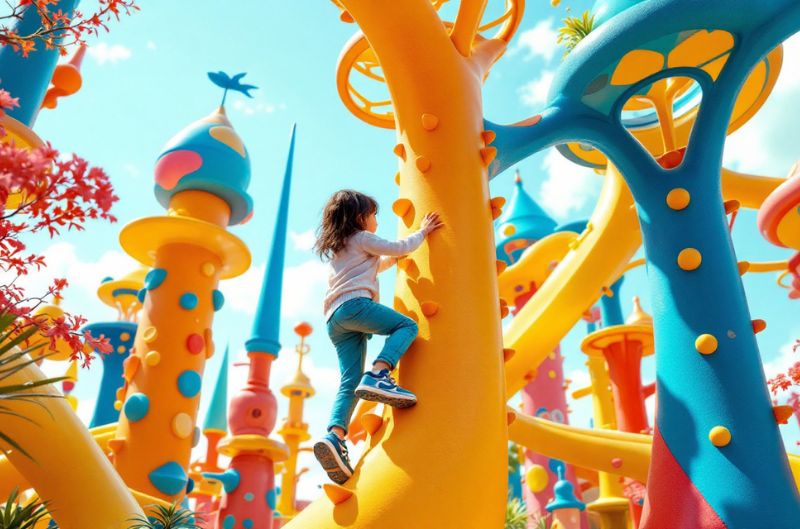
Innovative Climbing Structures for Playgrounds
Author: Austin Stanfel
Playgrounds have long been central to childhood play, providing spaces where children can explore, challenge themselves, and develop vital developmental skills. Among all types of playground equipment, climbing structures stand out as both timeless and constantly evolving. From traditional jungle gyms to today’s imaginative and inclusive designs, climbing elements offer children not just physical activity but opportunities to build resilience, creativity, and social bonds. As the industry advances, innovative climbing structures are transforming playgrounds into interactive landscapes that engage children of all ages and abilities.
Why Climbing Matters in Play
Climbing is not just about fun, it plays an essential role in child development. When children ascend structures, they are improving balance, strength, coordination, and body awareness. Beyond physical benefits, climbing challenges encourage risk assessment, problem-solving, and persistence, all key life skills. Socially, climbing equipment often fosters cooperative play, as children negotiate turns, help each other navigate obstacles, or invent imaginative games together.
Recognizing the influential role climbing plays, designers and manufacturers are pushing boundaries with designs that go far beyond ladders and monkey bars.
Trends in Innovative Climbing Structures
Modern climbing structures are characterized by their creativity, inclusivity, and adaptability. These trends reflect both advancements in materials and deeper understandings of child psychology and community needs.
Organic and Nature-Inspired Designs
Many new climbing structures mimic natural environments such as tree trunks, boulders, or rope bridges. These “playscapes” encourage children to experience the thrill of outdoor exploration, even in urban settings. The uneven surfaces and irregular shapes challenge children’s dexterity in ways similar to real-world climbing.
Suspended Rope Webs and Towers
Large net towers and three-dimensional rope webs create vertical climbing opportunities while maintaining visibility for supervisors. These structures are especially popular because they provide environments where multiple children can climb simultaneously in different directions, encouraging group interactions and imaginative play.
Inclusive Climbing Features
Innovations in climbing structures increasingly address accessibility. Gentle climbing ramps, transfer-support platforms, and wider handholds allow children of all abilities to enjoy the experience. Sensory-rich rope grids or tactile panels are often incorporated to make climbing accessible to children with neurodiverse needs.
Hybrid Climbing Play Systems
Some structures now combine climbing elements with slides, tunnels, and interactive panels, creating multi-use play hubs. These hybrid designs keep children engaged longer and appeal to diverse interests and play styles.
Themed and Imaginative Structures
Playgrounds are increasingly featuring climbing structures that resemble castles, ships, rocket towers, or jungle temples. These themed environments encourage imaginative role-play while providing physical challenges, seamlessly blending the mental and physical benefits of play.
Benefits of Innovative Designs
Climbing structures have evolved not just in appearance but in purpose. Innovative playground climbing equipment produces wide-ranging outcomes:
- Development of Executive Function: As children plot routes up complex climbing nets or tackle unusual angles, they learn planning and decision-making.
- Promotion of Social Learning: Rope towers and climbing domes become natural gathering points where cooperation, negotiation, and leadership arise organically.
- Confidence Building: Reaching the top of a challenging climb gives children a tangible sense of accomplishment.
- Encouragement of Risk-Taking in Safe Environments: Well-designed structures let children experience managed risk, helping them develop resilience and judgment.
- Intergenerational Play: Modern climbing structures are sturdy enough to accommodate teenagers and adults, encouraging family and community bonding through shared movement experiences.
Materials and Technology in Modern Climbing Structures
Another area of innovation lies in material choice and technology integration.
- Durable Rope and Net Systems: Modern high-strength rope is weather-resistant and capable of supporting large groups of climbers. Flexible connections allow for natural movement, providing children with an extra challenge.
- Sustainable Materials: Designers increasingly opt for recycled plastics, responsibly sourced wood, and powder-coated steel to balance durability with environmental responsibility.
- Augmented Reality Integration: Though still emerging, some structures incorporate technology to overlay digital challenges onto physical climbing, blending physical activity with interactive storytelling.
Examples of Innovative Climbing Structures
- Climbing Globes: Large spherical frameworks of interconnected ropes invite children to clamber in and out, testing creativity in navigation.
- Boulder Clusters with Grips: Sculpted concrete or fiberglass rocks provide safe alternatives to natural climbing, introducing children to the beginner-friendly activity of “bouldering.”
- Vertical Play Towers: Multi-level towers with observation decks and net tunnels offer thrilling heights while remaining safe with enclosed netting.
- Suspension Bridges: Wobbly bridges create excitement while reinforcing balance, teamwork, and courage.
Balancing Safety and Adventure
A central challenge in designing climbing structures is maintaining a balance between child safety and the essential opportunity for adventure. Overly restrictive designs can diminish the excitement, while overly risky structures can lead to hazards. Safety surfacing, appropriate fall heights, and adherence to standards such as ASTM and CPSC guidelines ensure that playground operators provide exhilarating experiences without unnecessary danger.
The Future of Climbing in Playgrounds
As communities seek playgrounds that are both functional and community-centered, innovative climbing structures will continue to play a pivotal role. Expect to see greater emphasis on:
- Multi-age climbing routes that grow with children
- Interactive technology woven into structures
- Greater cultural and artistic integration to reflect local heritage
- Adaptive structures that meet sustainability benchmarks
Climbing structures are no longer simple playground add-ons but centerpiece attractions that embody the future of play: dynamic, inclusive, imaginative, and growth-oriented. They transform playgrounds into landscapes of exploration, ensuring that children experience the joy of testing limits, solving challenges, and discovering their own strengths.

